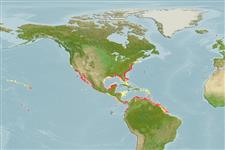Melita nitida Smith, 1873
| Native range | All suitable habitat | Point map | Year 2050 |

|
| This map was computer-generated and has not yet been reviewed. |
| Melita nitida AquaMaps Data sources: GBIF OBIS |
Изображение на Google |
No photo available for this species.
Классификация / Names народные названия | синонимы | CoL | ITIS | WoRMS
Malacostraca | Amphipoda | Melitidae
Environment: milieu / climate zone / пределы глубины / distribution range экология
; пределы глубины 0 - 60 m (ссылка 108754). Tropical
Distribution страны | регионы FAO | Ecosystems | места находок | интродукции
Western Central Atlantic: USA.
Length at first maturity / Size / Weight / Возраст
половая зрелость: Lm ? range ? - ? cm
Life cycle and mating behavior половая зрелость | размножение | нерест | Eggs | Fecundity | Larvae
Основная ссылка
ссылки | координатор | соавторы
Vittor, B.A. 2002 Gray's Reef benthic macroinvertebrate community assessment, April 2001. Final Report to NOAA under contract No. 50-DGNC-0-90024, NOAA NOS, Charleston, SC. (ссылка 3209)
Статус Красного Списка МСОП
(ссылка 130435: Version 2025-1)
Статус СИТЕС (ссылка 108899)
CMS (ссылка 116361)
Угроза для людей
Использование человеком
| FishSource |
инструменты
дополнительная информация
Max. ages / sizes
Length-weight rel.
Length-length rel.
Размерный состав
Mass conversion
численность
ресурсы в Интернет
BHL | BOLD Systems | CISTI | DiscoverLife | FAO(Publication : search) | Fishipedia | GenBank (Геном, Нуклеотид) | GloBI | 1 GoMexSI (interaction data) | Google Books | Google Scholar | Google | PubMed | Tree of Life | Wikipedia (Вперёд, поиск) | Zoological Record


